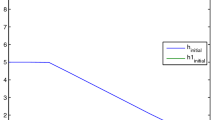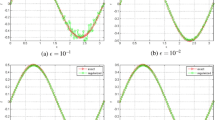Abstract
A mathematical optimal control method is developed to identify a hydraulic conductivity distribution in a density dependent flow field. Using a variational method, the adjoint partial differential equations are obtained for the density- dependent state equations used for the saline aquifer water flow. The adjoint equations are numerically solved in through a finite difference method. The developed method is applied to identify the hydraulic conductivity distribution through the numerical solution of an optimal control problem. To demonstrate the effectiveness of the optimal control method, three numerical experiments are conducted with artificial observation data. The results indicate that the developed method has the potential to accurately identify the hydraulic conductivity distribution in a saline water aquifer flow system.
Similar content being viewed by others
References
Bakker M. 2003. A Dupuit formulation for modeling seawater intrusion in regional aquifer systems. Water Resour Res, 39: 1131, doi: 10.1029/2002WR001710
Bastani M, Kholghi M, Rakhshandehroo G. 2010. Inverse modeling of variable-density groundwater flow in a semiarid area in Iran using a genetic algorithm. Hydrogeol J, 18: 1191–1203
Baxter G P, Wallace C C. 1916. Changes in volume upon solution in water of halogen salts of alkali metals: IX. J AM Chem Soc, 38: 70–104
Burnett W, Aggarwal P, Aureli A. 2006. Quantifying submarine groundwater discharge in the coastal zone via multiple methods. Sci Total Environ, 367: 498–543
Carrera J, Hidalgo J, Slooten L, Vázquez-Suñé E. 2010. Computational and conceptual issues in the calibration of seawater intrusion models. Hydrogeol J, 18: 131–145
Clemo T. 2007. MODFLOW-2005 Ground-Water Model-User guide to the adjoint state based sensitivity process (ADJ). Technical Report BSU CGISS 07-01-Center for the Geophysical Investigation of the Shallow Subsurface Boise State University
Church T. 1996. An underground route for water cycle. Nature, 380: 579–580
Glover R. 1959. The pattern of fresh-water flow in a coastal aquifer. J Geophys Res, 64: 457–459
Guo W, Langevin C. 2002. User’s guide to SEAWAT: A computer program for simulation of three-dimensional variable-density ground-water flow: Techniques of Water-Resources Investigations Book 6. Chapter A7
Hill M C. 1992. A computer program (MODFLOWP) for estimating parameters of a transient, three-dimensional, ground-water flow model using nonlinear regression. U.S. Geological Survey Open-File Report 91–484, 358
Holzbecher E. 1998. Modeling Density-Driven Flow in Porous Media. Berlin: Springer
Jackson C, Watson S. 2001. Modeling variable density groundwater flow. Phys Chem Earth-Part B: Hydrol, Oceans Atmos, 26: 333–336
Langevin C, Shoemaker W, Guo W. 2003. MODFLOW-2000, the U.S. Geological Survey modular ground-water model–documentation of the SEAWAT-2000 version with the Variable-Density Flow process (VDF) and the Integrated MT3DMS Transport process (IMT): U.S. Geological Survey Open-File Report 03–426
Li X Y, Hu B X, Burnett W C, Santos I. R, Chanton J P. 2009. Submarine ground water discharge driven by tidal pumping in a heterogeneous aquifer. Ground Water, 47: 558–568
Li H, Yang Q C. 2000. A least-squares penalty method algorithm for the inverse problems of steady state aquifer models. Adv Water Resour, 23: 867–880
Mao X, Enot P, Barry D, Li L, Binley A, Jeng D S. 2006. Tidal influence on behavior of a coastal aquifer adjacent to a low-relief estuary. J Hydrol, 327: 110–127
Moore W. 1996. Large groundwater inputs to coastal waters revealed by 226Ra enrichments. Nature, 380: 612–614
Poeter E, Hill M. 1998. Documentation of Ucode, A Computer Code for Universal Inverse Modeling, U.S. Geological Survey, Water-Resource Investigations Report 98-4080
Poeter P, Hill C. 1999. UCODE, A computer code for universal inverse modeling. Comput Geosci, 25: 457–462
Putti M, Paniconi C. 1995. Picard and Newton linearization for the coupled model for saltwater intrusion in aquifers. Adv Water Resour, 18: 159–170
Robinson C, Li L, Prommer H. 2006. Tide-induced recirculation across the aquifer-ocean interface. Water Resour Res, 43: W07428
Sahuquillo A, Hendricks Franssen H J W M, Gômez-Hernândez J J. 2000. Computational aspects of the coupled inversion of groundwater flow and mass transport, Groundwater Modeling. Proceedings of the ModelCARE 99 Conference Held at Zurich, Switzerland, September 1999. IAHS Publ. No. 265
Sanford W E, Konikow L F. 1985. A two-constituent solute transport mod el for groundwater having variable density. U.S. Geological Survey Water Resources Investigation Report 85-4279. 89
Sanz E, Voss C I. 2006. Inverse modeling for seawater intrusion in coastal aquifers: Insights about parameter sensitivities, variances, correlations and estimation procedures derived from the Henry problem. Adv Water Resour, 29: 439–457
Schincariol R, Schwartz F. 1990. An experimental investigation of variable density flow homogeneous and heterogeneous media. Water Resour Res, 26: 2317–2329
Shoemaker W. 2004. Important observations and parameters for a salt water intrusion model. Ground Water, 42: 829–840
Shor N Z. 1985. Minimization Methods for Non-Differentiable Functions, Springer Series in Computational Mathematics. Vol. 3. Berlin: Springer-Verlag
Simmons C, Fenstemaker T, Sharp J. 2001. Variable-density groundwater flow and solute transport in heterogeneous porous media: Approaches, resolutions and future challenges. J Contam Hydrol, 52: 245–275
Sun N Z, Yeh W. 1990. Coupled inverse problems in groundwater Modeling 2. Identifiability and Experimental Design. Water Resour Res, 26: 2527–2540
Sun N Z. 1994. Inverse Problems in Groundwater Modeling. Heidelberg: Springer
Sun N Z, Elimelech E, Ryan J. 2001. Sensitivity analysis and parameter identifiability for colloid transport in geochemically heterogeneous porous media. Water Resour Res, 37: 209–222
Sykes J F, Wilson J L, Andrews R W. 1985. Sensitivity analysis for steady state ground-water flow using adjoint operators. Water Resour Res, 21: 359–371
Townley L, Wilson J. 1985. Computationally efficient algorithms for parameter estimation and uncertainty propagation in numerical models of groundwater flow. Water Resour Res, 21: 1851–1860
Voss C I. 1984. SUTRA, A finite-element simulation model for saturated-unsaturated fluid density-dependent groundwater flow with energy transport or chemically-reactive single-species solute transport. U.S. Geological Survey Water Resources Investigations Report 84–4369. 409
Wilson J L, Metcalf D G. 1985. Illustration and verification of adjoint sensitivity theory for steady-state groundwater flow. Water Resour Res, 21: 1602–1610
Author information
Authors and Affiliations
Corresponding author
Rights and permissions
About this article
Cite this article
Hu, B.X., Cao, Y., Zhao, W. et al. Identification of hydraulic conductivity distributions in density dependent flow fields of submarine groundwater discharge modeling using adjoint-state sensitivities. Sci. China Earth Sci. 59, 770–779 (2016). https://doi.org/10.1007/s11430-015-5236-x
Received:
Accepted:
Published:
Issue Date:
DOI: https://doi.org/10.1007/s11430-015-5236-x




